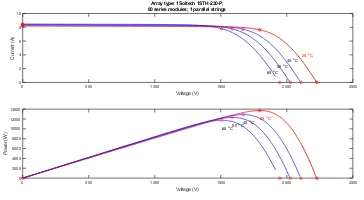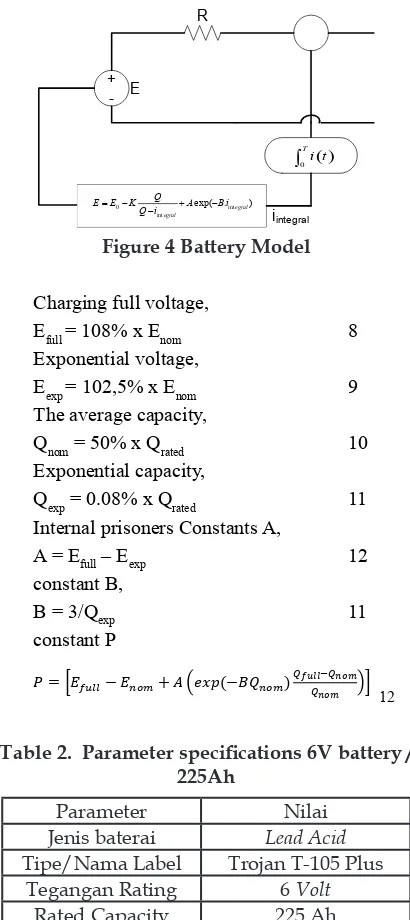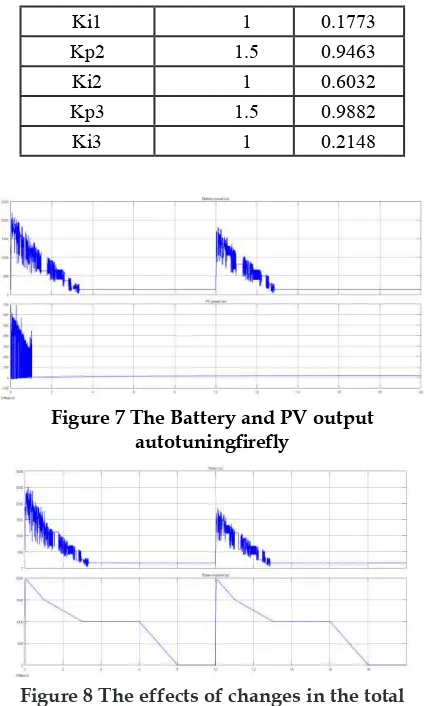7
PERFORMANCES DESIGN OF PHOTOVOLTAIC AND BATTERY
PARALELLIZATION USING PI-MPPT PROTOTIPE AUTOTUNED
BY FIREFLY OPTIMIZATION
1Dwi Ajiatmo
Department of Electrical Engineering, University of Darul Ulum Jombang, Indonesia, ajiatmo@ [email protected]
Imam Robandi
Department of Electrical Engineering Institute of Technology Sepuluh Nopember Surabaya, [email protected].
Abstrac
This paper describes the control system called Maximum Power Point Tracking (MPPT) for photovoltaic (PV) systems in the solar vehicle. The main manifestations of this system is to extract the maximum PV power in charge batteri small losses while keeping the design simple to use converter. The working principle of MPPT based convetional Controller autotuning Firefly Optimization (MPPT-CCFA) is to obtain the desired value of the reference current and voltage. MPPT-CCFA compare them with the values of the actual current and voltage PV to control the duty cycle value. Then the cycle is used to adjust the angle of the ignition switch (MOSFET gate) on the converter and the converter Buck Boost Boost The proposed method is shown through simulations done using MATLAB software. The simulation results show that the system is able to improve the efficiency of the state of charge (SOC%) signifi-cantly to approximately 99,98%.
Keyword: Maximum power point tracking (MPPT), photovoltaic (PV), boost, Firefly
Introduction1
The energy of sunlight as a source of renewable energy has the potential to grow larger. The potential of solar energy in Indo-nesia is very large: around 4.8 KWh / m2 / day, equivalent to 112,000 GWp, but which have been exploited only about 10 MWp. So-lar energy development is also earmarked for transportation. The use of fuel oil (BBM) stem from fossil has caused a lot of pollution and negative impact on air quality. Much research has been done to find new energy sources in Hybrid Electric Vehicle (HEV), among oth-ers, is FuelCell and photovoltaic (PV).[1]
1 International Symposium for Modern School Devel-opment, Social Science and Applied Technologies (ISMOSAT 2016) Grand Sakinah Mayong Jepara, 19 – 20 March 2016
PV panels are important elements to produce electric current after converting sunlight through a cell semiconductors due to the effect of photovoltaic, PV panels pro-vide the characteristic curve of non linear, in which the operating point is called maximum power point tracker (MPPT) varies depend-ing on the fluctuations of solar radiation and temperature, then to ensure optimum trans-fer of energy from the PV generator to the battery, the device adapter is needed to set the maximum power point on the optimal functioning, controlling DC-DC converter by the MPPT algorithm based techniques. [2][3] [4][5][6]
8 panels used to charge the battery. Depend-ing on the efficiency of the PV cell fabrication that now does not exceed 15% Increasing the efficiency of PV panels is difficult because of the development of technology and cost. On the other hand, the increase of the MPPT algorithms and strategies can be implement-ed at the cost of PV systems. [7][8][9]a bat-tery-integrated boost converter utilizing the distributed maximum power point tracking (DMPPT
Photovoltaic Generator
PV power plants convert sunlight into electrical energy. Solar radiation to produce an electrical current proportionally. PV cell voltage increases between 0.5 to 0.8 volts. Because each cell produces little power, so it takes some PV cells connected in parallel or in series in the form of PV panel. The panels are connected in parallel or in series to form a Array. equivalent circuit of PV cells includ-ing diodes, Shunt Prisoners, prisoners who represent a range of current flow, and current source depicted in Figure 1.[10]
Rp
Figure 1. Single diode model photovoltaic
cells connected in series provide greater out-put voltages. If the array composed of Np parallel connections of cell the photovoltaicand saturation currents may be expressed as Ipv = Ipv,cell.Np, Io=Io,cell.Np. the caracteristic of PV
Voltage (V)
0 500 1000 1500 2000 2500
C
Array type: 1Soltech 1STH-230-P; 60 series modules; 1 parallel strings
Voltage (V)
0 500 1000 1500 2000 2500
P
Figure 1. Karakteristik kurva I-V pada PV karena perubahan irradian
Voltage (V)
0 500 1000 1500 2000 2500
C
Array type: 1Soltech 1STH-230-P; 60 series modules; 1 parallel strings
Voltage (V)
0 500 1000 1500 2000 2500
P
Figure 2. P-V characteristic curve in NPV due to changes in irradiance.
Table 1. Data system Photovoltaic 1 Soltech 1STH-230-P diagram of a boost converter with maximum power point tracker (MPPT). In solar PV sys-tems, solar output voltage of the boost con-verter is set by the hybrid system to provide constant voltage.
9
Pertube and Observer (P & O) algorithm is one of the MPPT control algorithm used to generate the gate pulses for the operation of the boost converter. P & O algorithm oper-ates by periodically incrementing or decre-menting the PV array operating current and output power compared with the previous PV. If the result is positive, the control sys-tem moves the operating point of the PV ar-ray in the same direction, if not, the direction changed.[12][13][14][15]
Figure 3. DC-DC Boost Converter
Calculation of duty cycle (D):
D=1- (Vin/Vout) 2
Calculation of output current (Iout)
Iout = P/Vout 3
Calculation of resistance (R)
R=Vout/Iout 4
Calculation of inductor’s current (IL)
IL = 0.2 x Iin = 0.2 x Iout x Vout/Vin 5
Calculation of inductor (L)
L=(Vin x (Vout - Vin)) / (Ilx f x Vout) 6
Calculation of capacitor (C)
C = (Vout x D) / ((∆Vout/Vr) x f x R) 7
Storage Baterry
In many industrial sectors, due to in-creasing demand for energy hybrid power system that is used. high reliability power supply is indispensable for critical loads. During the pulsating voltage or complete in-terruption of power, energy must be supplied from local Energy Storage System (ESS). ESS merging conventional to hybrid power sys-tem basically relies on the choice of the good battery. There are many disadvantages as-sociated with low density batteries as power and charge / discharge cycles is limited.[7] [16][17]
The battery life is highly dependent on the stability of the use of electrical pulses
in-stead of average power. Variations currents cause voltage transients that can be interpret-ed by a low voltage detection circuit as the battery is depleted battery suddenly creates stress. high pulsed current has a value Root Mean Square (RMS), which can lead to in-creased battery loss. a sudden change in the
flow also reduces greatly the battery runtime.
[9]a battery-integrated boost converter utiliz-ing the distributed maximum power point
Figure 4 Battery Model
Charging full voltage,
Efull = 108% x Enom 8
Exponential voltage,
Eexp = 102,5% x Enom 9 The average capacity,
Qnom = 50% x Qrated 10 Exponential capacity,
Qexp = 0.08% x Qrated 11 Internal prisoners Constants A,
A = Efull – Eexp 12
Table 2. Parameter specifications 6V battery / 225Ah
Parameter Nilai
Jenis baterai Lead Acid
Tipe/Nama Label Trojan T-105 Plus
Tegangan Rating 6 Volt
Rated Capacity 225 Ah
Internal Resistance 0,06 Ohm
Firefly Algorithm
Firefly Algorithmis an algorithm
10
heuristic inspired by the characteristics of
fireflies. The algorithm was first discovered
by Dr. Xin-She Yang at the University of Cambridge in 2007. Then formulated three basic principles that can be used for solving the optimization problem, there are 3 basic
namely, reference.The movement of fireflies i were interst by the appeal of fireflies brighter j is defined as.[19][20]
)
4
;E<;7D<;7E<
I '6 I'-
;,<;E<;7.<
8
8
! 1)
-(F78.+( .
(-(F785-C+( ,
-KFC8+K 78
(-KF88.+K 77
/
%-%F(L( 75
)-)FB4K 77
!"#$%&''$)*+($)*+75
5 D 4 55C%
/
A
4>* &$78C
I D
I 55C% / I 8-8D"
0$
= M$' N @ 588E # - & ;7,<;58<
,- - .(/012
3
4 5 -6 7 8- 7B
1$ .
1
! C
! D 9 / ! %
2$ .
"# /$ ! 6 2-2-
B I ! 2- 2 # /$ !
27 7C 8BBD7 27 7 87EEB 25 7C 8,1DB 25 7 8D8B5 2B 7C 8,..5 2B 7 8571.
13
Simulasi Model
The simulation using 4 photovoltaic sources in parallel
Figur 5 PV system structure
Figure 6 Global simulink model PI autotuning
Firefly Algorithm
Simulasi results and Discussion
Optimization of simulation results with
PI-Firefly acquired for the amount of Kp, Ki,
with load R = 20 Ohm, as the table below.
Table 3. Result Ferformance magnitude of the value of Kp, Ki after optimization with
PI-Firefly
Magnitude PI PI-FF
Kp1 1.5 0.3361
Ki1 1 0.1773
Kp2 1.5 0.9463
Ki2 1 0.6032
Kp3 1.5 0.9882
Ki3 1 0.2148
Figure 7 The Battery and PV output
autotuningfirefly
Figure 8 The effects of changes in the total power to dynamic loads
Figure 9 The state of charge of battery, Curent
and voltage with optimization firefly control
Conclusion
In this paper, Performance Photovoltaic, Battery parallelization using a basic proto-type of the conventional MPPT Controllers
Autotuning Firefly proposed. The design
11
mutual maintain energy availability. Design procedures are presented and experiments were conducted to validate the effective-ness of the proposed method. Comparing
with PI autotuning method fireflies in MPPT,
with the proposed method of battery state of charge of about 99.98%, respectively.
Referensi
[1] S. Aji, D. Ajiatmo, I. Robandi, and H. Suryoatmojo, “MPPT Based on Fuzzy Logic Controller (FLC) for Photovoltaic (PV) System in Solar Car,” Mechatronics, Electr. Power, Veh. Technol., vol. 4, no. 2, pp. 127–134, 2013.
[2] B. Amrouche, M. Belhamel, and a
Guessoum, “Artificial intelligence
based P & O MPPT method for photovoltaic systems,” Rev. des Energies Renouvelables ICRESD-07 Tlemcen, pp. 11–16, 2007.
[3] I. V. Banu, R. Beniuga, and M.
Istrate, “Comparative analysis of the perturb-and-observe and incremental
conductance MPPT methods,” 2013
- 8th Int. Symp. Adv. Top. Electr. Eng. ATEE 2013, no. 1, pp. 23–26, 2013.
[4] A. Borni, A. Bouchakour, and N.
Terki, “Buck-Boost Converter System Modeling and Incremental Inductance Algorithm for Photovoltaic System via MATLAB / Simulink,” pp. 1–6, 2014. [5] S. Hasmah, “Voltage tracking of Dc-Dc
Boost converter using Gaussian Fuzzy Logic Controller,” no. January, 2012. [6] J. J. Lee, “Analysis of Small-Signal
Model of a Pwm Dc-Dc Buck-Boost Converter in Ccm.,” Response, p. 98, 2007.
[7] S. R. Gurrala and K. V. Lakshmi, “A Novel Bidirectional DC-DC Converter with Battery Protection,” vol. 2, no. 6, pp. 4261–4265, 2012.
[8] I. Engineering, “Integration of Super Capacitor and Battery for Voltage Fluctuations Mitigation in DC Hybrid System,” pp. 7606–7615, 2014.
[9] Y. Du and D. D. C. Lu, “Battery-integrated boost converter utilizing
distributed MPPT configuration for
photovoltaic systems,” Sol. Energy, vol. 85, no. 9, pp. 1992–2002, 2011.
[10] M. G. Villalva, J. R. Gazoli, and E. R.
Filho, “Comprehensive Approach
to Modeling and Simulation of
Photovoltaic Arrays,” IEEE Trans.
Power Electron., vol. 24, no. 5, pp. 1198– 1208, 2009.
[11] M. G. Villalva, J. R. Gazoli, and E. Ruppert Filho, “Modeling and circuit-based simulation of photovoltaic arrays,” 2009 Brazilian Power Electron.
Conf. COBEP2009, vol. 14, no. 1, pp. 1244–1254, 2009.
[12] A. Yadav and S. Thirumaliah,
“Comparison of mppt algorithms for dc-dc converters based pv systems,”
Int. J. …, vol. 1, no. 1, pp. 476–481, 2012.
[13] R. Sowmya, “Comparison of PI & Fuzzy Logic Controlled Dual Active Bridge DC to DC Converter Systems,” no. 03, pp. 21–29, 2015.
[14] S. M. Sadek, F. H. Fahmy, A. E.-S. a. Nafeh, and M. A. El-Magd, “Fuzzy P & O Maximum Power Point Tracking Algorithm for a Stand-Alone Photovoltaic System Feeding Hybrid Loads,” Smart Grid Renew. Energy, vol. 05, no. February, p. 19, 2014.
[15] T. P. Sahu and T. V. Dixit, “Modelling and analysis of perturb and observe and incremental conductance MPPT algorithm for PV array using ??uk converter,” 2014 IEEE Students’ Conf. Electr. Electron. Comput. Sci. SCEECS 2014, vol. 4, no. 2, pp. 213–224, 2014. [16] J. António, B. Vieira, and A. M. Mota,
“Maximum Power Point Tracker Applied in Batteries Charging with Photovoltaic Panels,” Ind. Electron. 2008. ISIE 2008. IEEE Int. Symp., pp. 202 – 207, 2012.
12 “Battery and Supercapacitor Charger Based on Llc Converter,” vol. 51, no. 2, pp. 6–13, 2010.
[18] M. Jongerden and B. Haverkort, “Battery modeling,” Thecnical Rep. Fac. Electr. Eng. Math. Comput. Sci., p. 18, 2008.
[19] P. Jitpakdee, “Image Clustering using
Fuzzy-based Firefly Algorithm.”
[20] A. JAZIDIE, “a New Combination
Method of Firefly Algorithm and
T2Fsmc for Mobile Inverted Pendulum Robot.,” J. Theor. …, vol. 47, no. 2, pp. 824–831, 2013.
Dwi Ajiatmo, received the ST. degree in electrical engineer-ing from Darul Ulum of Uni-versity, Jombang, Indonesia in 1996, and MT degree in sys-tem electric energy from the Gadjah Mada of University, Yo-gyakarta, Indonesia in 2004. At this time as a candidate Dr.Eng. in Electrical Engineering at Sepuluh Nopember Institute of Technolgy, Surabaya, Indonesia. The current research fo-cused on Design and Implementationof Con-trolSystem OptimizationMaximum Power PointTracking(MPPT)
UsingHybridFuzzy-Logic Controller-FireflyAlgorithm (FLC-FA)
On ASolarPhotovoltaicSystemVehicle.
Imam Robandi, He recived
B.Sc. degree in power engineer-ing from Sepuluh Nopember Institute of Technolgy, Sura-baya, Indonesia in 1989, and M, Eng., degree in Enginering from the Bandung Institute of Technology, Indonesia in 1994 and Dr.Eng. degree in the Department of Electrical Engi-neering from Tottori University, Japan, 2002. He is currently Professor and as Chairman of the Laboratory of Power System Operation and Control in the Department of Electrical Engineering, Sepuluh Nopember Institute of Technology, Surabaya, Indonesia. His cur-rent reasearch interest includes Stability of power systems, Electric Car, Solar cell and


